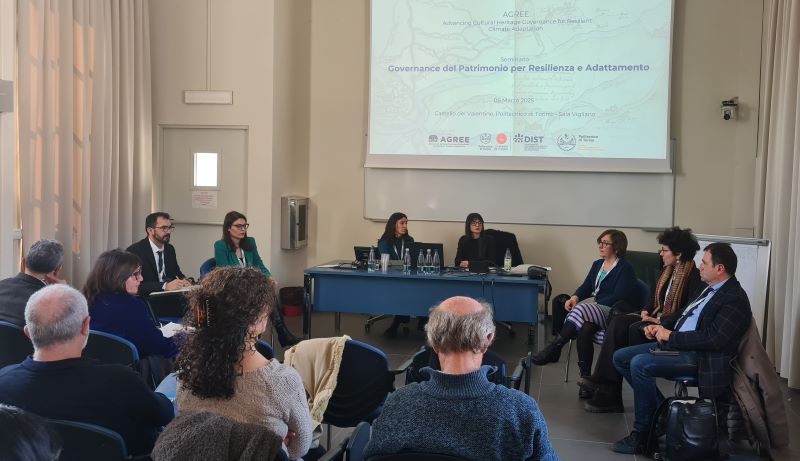
In recent years, discussions on territorial governance and climate risk management have gained increasing prominence in international policies. The rising frequency of extreme weather events, coastal erosion, hydrogeological (groundwater) instability, and uncontrolled urbanization have made it imperative to rethink planning and management models.
However, cultural heritage – understood not only as a collection of historic buildings but also as a complex urban and landscape system – is often seen as a constraint rather than an asset in making cities more resilient. Risk management and climate adaptation strategies are typically based on infrastructural solutions that overlook the potential of integrating heritage into a broader, more holistic approach.
Yet, research increasingly demonstrates that preserving and reusing historic assets can contribute significantly to sustainability, leveraging traditional materials, construction techniques, and historical knowledge that have already proven their adaptability over time.
This idea formed the basis of our Governance del Patrimonio per Resilienza e Adattamento seminar, which took place on 6 March 2025, at the Politecnico di Torino, Italy. Organised as part of our international project Advancing Cultural Heritage Governance for Resilient Climate Adaptation (AGREE), the event aimed to foster interdisciplinary dialogue and encourage a more integrated approach to risk management and heritage governance.
Held within the School of Specialisation in Architectural and Landscape Heritage, the seminar engaged researchers, policymakers, technical experts, and professionals from diverse fields, offering insights and expertise on the topics addressed.
The seminar was structured into three thematic sessions, each exploring different aspects of the relationship between cultural heritage and risk management. The discussions that followed highlighted the need to bridge institutional and disciplinary gaps, fostering a more integrated approach that brings together expertise from urban planning, environmental engineering, heritage conservation, and social sciences.
The first session focused on the role of cultural heritage in mitigating hydrogeological risks and adapting to climate change. Marco Gallo, Regional Minister for Piedmont, opened the discussion by emphasising the importance of an integrated approach to landscape management and existing infrastructure to enhance territorial resilience. Michela Favaro, Deputy Mayor of Turin, followed with an overview of the city’s urban regeneration strategies, highlighting the need for active community involvement in decision-making processes.
Elena Frugoni and Cristina Lucca, Heritage Officers at the Superintendency of Archaeology, Fine Arts, and Landscape, examined the case of Turin’s riverfront, discussing the challenges of its conservation and the need for more flexible strategies that balance flood management with public accessibility, fostering a stronger connection between historical heritage and urban spaces.
Gianluca Zanichelli (AIPo – the Interregional Agency for the Po River) explored the role of hydraulic infrastructure in risk prevention, demonstrating how effective planning can significantly reduce the impact of floods and landslides. Paola Mazzoglio, a researcher at the Department of Environment, Land and Infrastructure Engineering (DIATI), Politecnico di Torino, introduced innovative hydrological models for monitoring extreme weather events, stressing the importance of integrating climate data into territorial management policies.
The second session focused on the relationship between historic cities and water resource management. Simona Barbarino (ARPA Piemonte – Regional Environmental Protection Agency) provided an overview of the evolution of meteorological warning systems and their impact on emergency responses, while Professor Daniele Ganora (DIATI, Politecnico di Torino) examined the challenges of pluvial (surface water) flooding in urban areas, discussing strategies to mitigate the effects of sudden heavy rainfall.
The session also featured case studies, including an intervention by Alessandro Trabucco and Claudia Cevrero (Municipal Civil Protection Service and Municipality of Moncalieri), who presented the flood risk mitigation strategies implemented in Moncalieri in response to past flooding events. Their analysis highlighted the effectiveness of preventive measures in reducing hydrogeological risk.
A notable contribution came from Francesca Paveggio and Daria Guzzinati (World Heritage Porticoes Office, Municipality of Bologna), who explored the challenges of conserving and adapting Bologna’s porticoes, an iconic urban heritage site in a city that often experiences flooding. Their presentation demonstrated how historic structures can actively contribute to urban resilience.
The final session fostered a discussion on governance policies and long-term adaptation strategies. Francesco Tresso, Councilor for the Municipality of Turin, outlined the city’s approach to enhancing urban resilience, emphasising the need for an integrated framework that connects urban planning with risk management. Massimo Bastiani (National River Contracts Board) explored the role of River Contracts as a tool for participatory governance, highlighting the potential of nature-based solutions in mitigating hydrogeological risk.

In a similar way, drawing examples from European contexts, Mattia Scalas (CMCC– Euro-Mediterranean Center on Climate Change) underscored the importance of climate data and predictive models as key components of effective adaptation planning. Finally, Grazia Brunetta and Angioletta Voghera (Responsible Risk Resilience Centre – R3C, Politecnico di Torino) proposed a new paradigm for territorial resilience, advocating for integrated assessment tools and tailored adaptation strategies that respond to the specific challenges of different urban areas.
The seminar highlighted the need for a fundamental shift in heritage governance and risk management. It became evident that adaptation strategies must incorporate cultural heritage as an active element in resilience planning, rather than treating it as a secondary concern or a constraint to integrated governance.
The seminar’s findings will be compiled into a summary report, currently being prepared by students from the School of Specialization, including Akila Rose Ferrari and Fausto Finanze, who played an active role in the initiative. This document will serve as a valuable resource for future territorial management policies and a scientific reference for the key themes discussed during the event.
Looking ahead, the AGREE project will continue developing adaptive governance models that integrate cultural heritage into broader climate adaptation frameworks. The aim is to ensure that historic environments are not only preserved but actively contribute to building more resilient and sustainable territories.
Author: Giulia Bergamo








